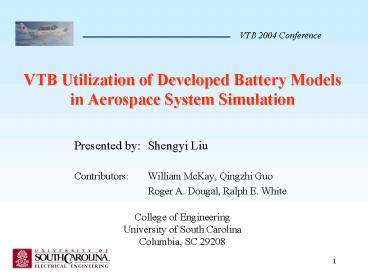VTB Utilization of Developed Battery Models in Aerospace System Simulation - PowerPoint PPT Presentation
1 / 24
Title:
VTB Utilization of Developed Battery Models in Aerospace System Simulation
Description:
VTB Fortran wrapper interface can make the best use of intellectual resources ... Tests prove the wrappers work correctly and allow the advanced battery models to ... – PowerPoint PPT presentation
Number of Views:72
Avg rating:3.0/5.0
Title: VTB Utilization of Developed Battery Models in Aerospace System Simulation
1
VTB Utilization of Developed Battery Modelsin
Aerospace System Simulation
- Presented by Shengyi Liu
- Contributors William McKay, Qingzhi Guo
- Roger A. Dougal, Ralph E. White
College of Engineering University of South
Carolina Columbia, SC 29208
2
Objectives
- Incorporate the latest and best lithium ion
battery models developed by electrochemists into
the VTB system simulation environment - Demonstrate use of those battery models for cycle
life prediction in a complex satellite power
system environment (rather than with simple load
profiles)
3
Significance
- VTB Fortran wrapper interface can make the best
use of intellectual resources - Many physics-based models were developed in
Fortran language due to - Suitable for scientific calculation
- Ease with programming
- One of the earliest computer language (back to
1950s) - VTB utilization of high-fidelity models improves
the dependability and reduces the uncertainty of
the simulation results - Most Fortran written models are described by
partial-differential equations and solution
algorithms are of higher order accuracy.
4
Approach
VTB Environment (MFC C Based)
VTB Wrapper
Battery Model (Fortran-based)
Complex system time-domain simulator
- Develop wrapper object that
- Synchronizes the Fortran executable to the system
simulation - Provides an interface that can accomodate
natural, signal and data coupling, and an
icon-based method for connecting to the system - Extracts data for viewing, plotting, or 3D
animation of battery data - Maintains the integrity of the Fortran-based
model (no change of math and algorithm)
5
High-Fidelity Battery Models
- Advantages
- Chemistry-principle-based
- Mathematical description in PDEs
- Highly accurate and reliable
- Problems
- Model development assumed use in stand-alone
simulator, not in generic simulation environment - Programmed in Fortran language which does not
support the class structures of the MFC
(Microsoft Foundation Class) C native model
format for VTB - Solution
- Apply VTB wrapper techniques to step the Fortran
code and to map signal connections into
natural connections that allow topological
definition of the study system
6
Features of MSA Li-Ion Battery Model
- Physics-based pellet model programmed in Fortran
- Intercalation processes at positive and negative
electrodes are considered - Average and surface concentrations of Li at the
intercalation particle are predicted - Capacity fade effects are represented by
- Loss of active material at the cathode
- Growth of SEI during the recharging process
7
Chemical Processes in MSA dual insertion Cell
8
Half-Cell Lithium Polymer Battery Model (Doyle)
- Based on the concentrated solution theory and the
transport equations. - Li insertion into the active cathode is solved
by application of Duhamels superposition
integral. - The solution includes the spatial distributions
of potentials, current densities, concentrations
for each time step.
9
Doyles Half-Cell Lithium Polymer Battery Model
- Doyles 1-D half-cell model
10
Wrapper verified by comparing simple system to
original stand-alone simulation
Constant current load 0.5 C rate (0.83 A)
All results are identical
11
Wrapper verified by comparing simple system to
original stand-alone simulation
Constant current load 0.1 C rate discharge
All results are identical
12
Cycling (75x2000 s) performance at 1C rate
13
Capacity Fade Effect Voltage Decrease
14
Capacity fade effect Change of SOC
15
Capacity Fade SEI thickness increase
16
Battery performance in complex system
17
Load Current Profiles
18
Solar Array Voltage and Current (2 orbits)
19
Li-ion Cell Voltage and Current (5 Orbits)
20
Battery SOC (5 Orbits)
21
Side Reaction Current in battery (5 Orbits)
22
SEI Buildup in battery (5 Orbits)
23
Battery Behaviors for More Complicated Load
Profiles (5 orbits)
24
Conclusions
- Wrapper was developed to incorporate lithium ion
and lithium/polymer battery models into VTB
system studies. - Tests prove the wrappers work correctly and
allow the advanced battery models to now be used
in simulations of complex systems. - Satellite power systems that use these battery
models now allow realistic study of cycling and
aging phenomena.































